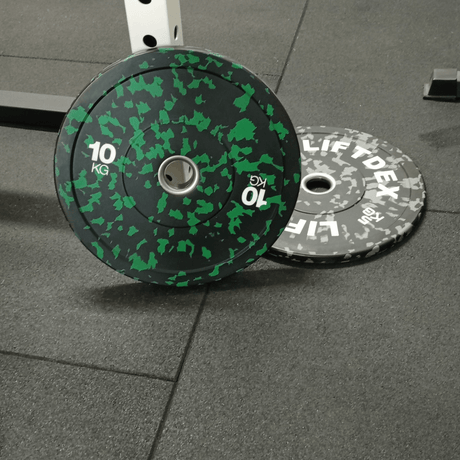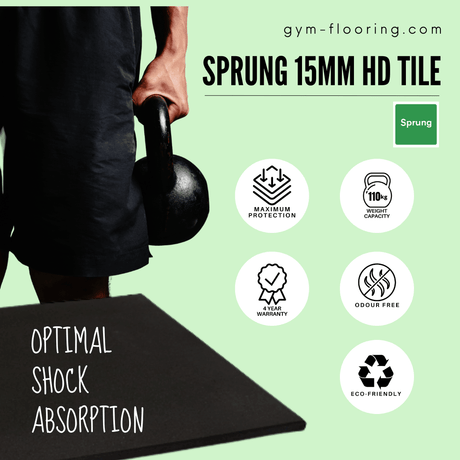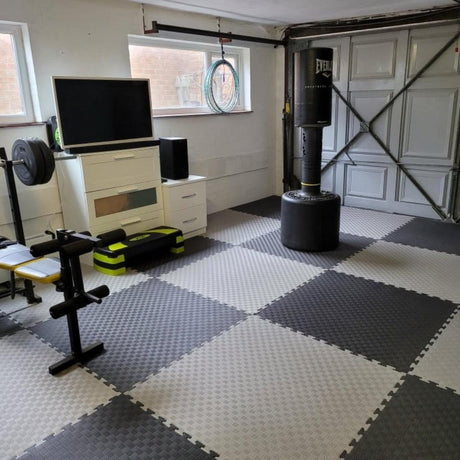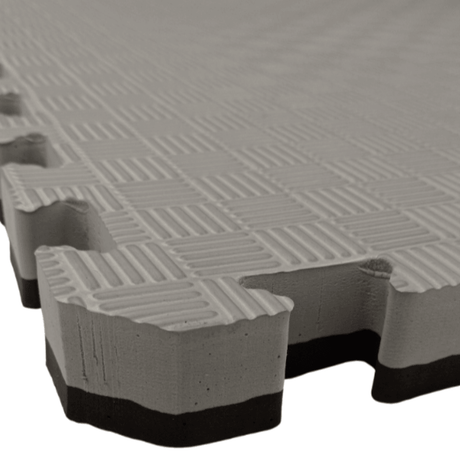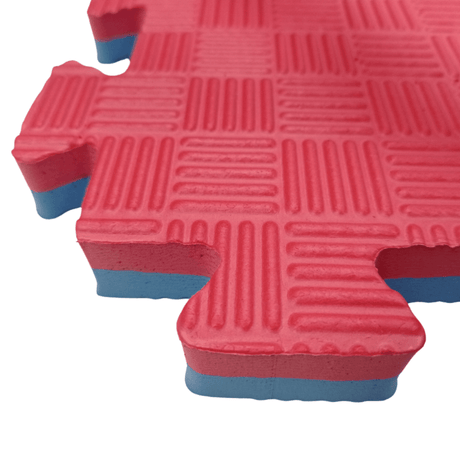When it comes to setting up a home gym for Olympic weightlifting, selecting the right flooring is just as important as investing in quality barbells, bumper plates, or racks. A good floor should not only protect your subfloor from the impact of heavy lifts but also safeguard your body from injury and minimize damage to your equipment.
Additionally, shock absorption, sound reduction, and ease of installation make a huge difference, especially when you're lifting in a home or garage setting.

In this short guide, we'll walk through the best flooring options that tick all these boxes.
Rubber Tiles: Thick, Durable, and Protective
Rubber tiles are by far one of the most popular choices for Olympic weightlifting flooring at home. They are available in a wide range of thicknesses, starting from 11mm up to 63mm.

The thicker the tile, the better it performs at absorbing the shock from dropping heavy weights, thus protecting both your subfloor and your expensive equipment. The ideal thickness for any type of weightlifting is 20mm and above. For Olympic lifting, 30mm and above provides the best protection.
Key Benefits of Rubber Tiles:
- Excellent Shock Absorption: The thicker the tile the more effectively it absorbs shock, reducing the risk of injury to your body while minimizing damage to your equipment and floor.
- Sound Reduction: Weightlifting can be noisy, especially when you're doing Olympic lifts like clean and jerks or snatches. Rubber tiles reduce noise significantly, making them perfect if you're sharing a space with others or don't want to disturb neighbours.
- DIY-Friendly Installation: Installing rubber tiles is straightforward. They can be fitted with or without adhesive or come with hidden inserts for an even easier installation. You can also cut them to size with a utility knife, making them an easy weekend project. Most suppliers provide easy-to-follow guidelines and video tutorials for fitting support.
- Low Maintenance: Rubber flooring is resistant to moisture, stains, and heavy foot traffic, meaning it requires minimal upkeep. A quick sweep or mop is all that’s needed to keep it clean.
- Durability: Thick rubber tiles (especially those in the 40mm–63mm range) are built to last, even when subjected to the rigours of Olympic weightlifting.
Rubber tiles offer great versatility, making them perfect for both heavy lifters and general fitness enthusiasts. With thicker tiles (such as 40mm+), you can be sure that your floor is protected even when dropping weights from overhead.
EVA Foam Tiles: Lightweight and Budget-Friendly
If you’re looking for a more affordable alternative that still offers solid shock absorption, 40mm foam tiles are another great option. While not as dense as rubber, they provide enough cushioning for moderate weightlifting and general fitness.

Key Benefits of Foam Tiles:
- Lightweight and Affordable: Foam tiles are typically lighter and less expensive than rubber tiles, making them a great option for lifters on a budget.
- Sound and Shock Absorption: Foam tiles absorb impact and sound reasonably well, especially for those who aren’t dropping heavy weights from great heights.
- Easy DIY Installation: Foam tiles also come with interlocking edges, making installation simple and tool-free. You can easily lay them over almost any surface, including concrete, wood, or carpet.
- Body Protection: The softness of foam tiles provides a little extra cushion underfoot, reducing stress on your joints during lifts.
While foam tiles may not offer the same level of protection as thicker rubber options, they are ideal for lighter weightlifting routines and are an excellent solution if you're setting up a budget-friendly home gym.
Weightlifting Platforms: The Ultimate Olympic Setup
For those serious about their Olympic weightlifting, nothing beats the traditional weightlifting platform. These platforms typically consist of a wooden centre surrounded by rubber tiles or mats for shock absorption and noise reduction. While more expensive than rubber or foam tiles alone, weightlifting platforms offer the ultimate protection and durability for both your home gym and your body.
Key Benefits of Weightlifting Platforms:
- Maximum Protection for Your Subfloor: Platforms are designed to absorb the tremendous impact of repeated heavy lifts, protecting your subfloor better than almost any other flooring option.
- Stable Lifting Surface: The wooden centre provides a stable and firm base, ideal for Olympic lifts where stability is key to maintaining proper form.
- Enhanced Shock Absorption: The surrounding rubber tiles or mats protect both your equipment and the floor from dropped weights, offering superb shock absorption and reducing noise.
- Customisable: Many lifters build their own platforms at home using a combination of plywood and rubber mats, making it a flexible DIY project for those who want a custom setup.
- Consistency: Having a dedicated platform for lifting allows consistency in technique and form for serious lifters and competitors.
Although building or buying a weightlifting platform requires a little more investment in both time and money, it offers a superior long-term solution for Olympic weightlifting at home.
Why Choose These Flooring Options?
All three options—rubber tiles, foam tiles, and weightlifting platforms—are specifically designed to meet the unique demands of Olympic weightlifting. Here’s why these choices excel in home gym settings:
Injury Prevention
The last thing you want while lifting is to suffer from an injury caused by improper flooring. Rubber and foam tiles offer the right balance of cushioning and stability to reduce stress on your joints and muscles. Plus, the shock absorption protects your body from the impact of heavy weights.
Subfloor Protection
Olympic weightlifting involves repeatedly dropping weights from overhead, and without the right flooring, your home’s subfloor can suffer damage. Rubber tiles and weightlifting platforms are built to absorb these impacts, preventing cracks and other damage.

Noise and Vibration Reduction
Lifting heavy can be noisy, especially if you’re training in a garage or shared space. Rubber tiles and weightlifting platforms minimise the sound and vibrations caused by dropped weights, making your gym a little more home-friendly.
DIY Installation
One of the best things about rubber and foam tiles is that they’re incredibly easy to install yourself. No need to hire contractors or worry about adhesives. Interlocking systems make it simple to lay the flooring in a day, and you can easily remove or rearrange them as needed.

Minimal Maintenance
Once installed, these flooring options require very little maintenance. They’re resistant to wear and tear, moisture, and stains, so you can focus on your lifts instead of cleaning and repairs.
Conclusion: Investing in the Right Floor for Your Lifting Space
Whether you're a serious Olympic weightlifter or just starting with strength training, choosing the right flooring can enhance your workout experience and protect both your equipment and your body. Thicker rubber tiles (20mm to 63mm), dense foam tiles, and custom weightlifting platforms offer excellent shock absorption, sound reduction, and DIY installation ease. Plus, their durability ensures that your subfloor remains intact even after the heaviest of lifts.
With the right flooring, you can create a safe, efficient, and long-lasting weightlifting environment in the comfort of your home.





